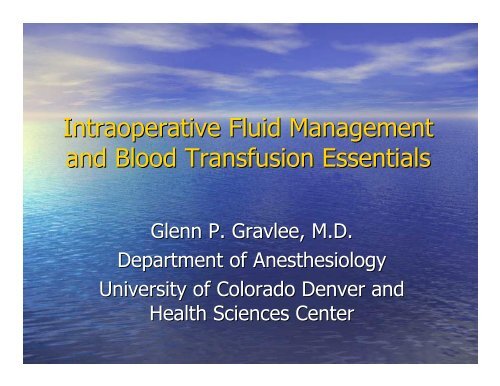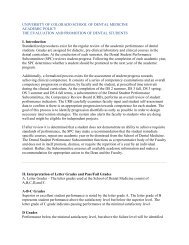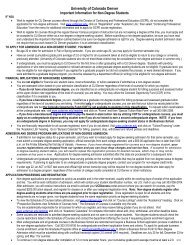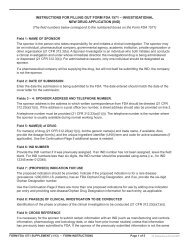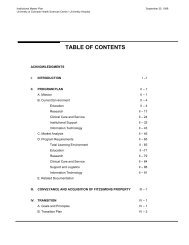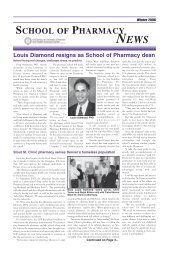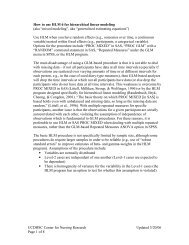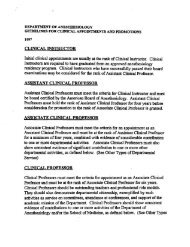Intraoperative Fluid Management and Blood Transfusion Essentials
Intraoperative Fluid Management and Blood Transfusion Essentials
Intraoperative Fluid Management and Blood Transfusion Essentials
You also want an ePaper? Increase the reach of your titles
YUMPU automatically turns print PDFs into web optimized ePapers that Google loves.
<strong>Intraoperative</strong> <strong>Fluid</strong> <strong>Management</strong><br />
<strong>and</strong> <strong>Blood</strong> <strong>Transfusion</strong> <strong>Essentials</strong><br />
Glenn P. Gravlee, M.D.<br />
Department of Anesthesiology<br />
University of Colorado Denver <strong>and</strong><br />
Health Sciences Center
Body <strong>Fluid</strong> Distribution
Perioperative <strong>Fluid</strong> “Stressors Stressors”<br />
• NPO status pre-op, intra-op, <strong>and</strong> post-op<br />
• Patient’s Patient s primary disease causes<br />
intravascular fluid depletion:<br />
trauma/bleeding, bowel disorders<br />
(obstruction, diarrhea), hyperglycemia<br />
with osmotic diuresis, diuresis,<br />
diabetes insipidus, insipidus<br />
poorly controlled hypertension, chronic<br />
use of diuretics
Perioperative <strong>Fluid</strong> Stressors (cont)<br />
• Patient’s Patient s primary disease causes<br />
intravascular fluid excess: poorly<br />
controlled congestive heart failure, renal<br />
failure overdue for dialysis, pre-eclampsia<br />
pre- eclampsia<br />
(can go either way – hypovolemia or<br />
hypervolemia)<br />
hypervolemia<br />
• Postoperative nausea or vomiting delays<br />
resumption of p.o. p.o.<br />
fluid intake
Perioperative <strong>Fluid</strong> “stressors stressors” (cont)<br />
• <strong>Intraoperative</strong> fluid losses can be obvious<br />
or subtle<br />
• Obvious: bleeding in surgical field<br />
• Subtle: Evaporative losses from exposed<br />
peritoneal surfaces, sequestration of fluid<br />
in extravascular extracellular space(so- called “third third spacing”), spacing ), sympathectomy<br />
from spinal or epidural anesthesia
Calculating a <strong>Fluid</strong> Deficit<br />
• <strong>Fluid</strong> requirement for normal adults:<br />
<strong>Fluid</strong>s/hour= 60 ml + (Wt in Kg-20)ml<br />
• Probably plateaus at 90-100 kg body wt,<br />
so not more than 140 ml/hr<br />
• Deficit is calculated based on hours of NPO<br />
status: 8 hrs NPO for a 70 kg Pt: 8 X<br />
(60+60)+ 960 ml
<strong>Fluid</strong> Deficit (cont)<br />
• So an 80 kg Pt who has been NPO for 8<br />
hours is almost 1 L behind before before<br />
anesthesia <strong>and</strong> surgery<br />
• Replace prior to anesthetic induction?<br />
Probably OK, but most would replace half<br />
of it then, <strong>and</strong> replace the second half<br />
over the first hour thereafter (there’s (there s no<br />
gold st<strong>and</strong>ard)
Maintenance <strong>Fluid</strong>s<br />
• Hourly basal <strong>Fluid</strong> Requirement is<br />
approximately 100-140 ml/hr for most<br />
adults<br />
• Add in blood loss:<br />
– Crystalloid replacement (balanced salt<br />
solutions): 3-4 ml of crystalloid per 1 ml of<br />
blood loss<br />
– Colloid or blood product replacement: 1 ml of<br />
solution per 1 ml of blood loss
Third Spacing<br />
• Controversial Subject<br />
• Concept is that local trauma causes edema to<br />
develop, <strong>and</strong> that this edema fluid does not<br />
maintain the usual connection between<br />
interstitial <strong>and</strong> intravascular spaces<br />
• Greatest third space losses: open laparotomies<br />
(4-6 ml/kg/hr possibly), open thorax with<br />
inflamed pleura (perhaps 2-4 ml/kg/hr)
Third Spacing (cont)<br />
• Not a big consideration for superficial<br />
(breast, skin) or peripheral (h<strong>and</strong>, foot,<br />
knee) procedures: 0-2 ml/kg/hr<br />
• Some believe that the third spacing<br />
concept is overrated <strong>and</strong> has given<br />
anesthesiologists an excuse for<br />
overloading patients with fluids
So is third third spacing overrated?<br />
• There probably is some some 3 rd spacing, but<br />
assumed third space formulas for fluid losses<br />
have been too high (e.g., maybe it peaks at 3-4<br />
ml/kg/hr, <strong>and</strong> perhaps only when the bowel<br />
serosal surfaces are fully “exposed exposed”)<br />
-Some have assumed as much as 8-10 ml/kg/hr<br />
under these conditions: TOO HIGH<br />
• Recent studies suggests that conservative fluid<br />
management improves outcomes with colon <strong>and</strong><br />
pulmonary resections (others yet to come?)
Rational <strong>Fluid</strong> <strong>Management</strong> Plan for<br />
a 70 kg man undergoing an open<br />
small bowel resection – NPO for 6<br />
hours<br />
• <strong>Fluid</strong> deficit: 110 ml/hr X 6 hrs = 660 ml<br />
• Give approx 350 ml of LR pre-induction<br />
• 1 st hour: Maintenance (110 ml) plus<br />
remaining deficit (~300 ml) plus approx 4<br />
ml/kg/hr 3 rd space deficit (280 ml) = 690<br />
ml
Rational <strong>Fluid</strong> <strong>Management</strong> Plan for a<br />
70 kg man undergoing an open small<br />
bowel resection – NPO for 6 hours<br />
• Second hour: Assume 100 ml blood loss:<br />
Maintenance (110 ml) plus 3 rd space loss (280<br />
ml) plus 4 X 100 ml to replace blood loss = 790<br />
ml<br />
• If the bowel is not fully exposed to the room (it’s (it<br />
in a bag or it’s it s sequestered intra-abdominally),<br />
decrease the 3 rd space assumption<br />
• Laparoscopic approach greatly decreases 3 rd<br />
spacing: probably 2 ml/kg/hr or less
And don’t don t forget:<br />
Urine output counts in the fluid<br />
loss category: replace 1:1 with<br />
crystalloid
Crystalloids<br />
• Approximately 25% remains intravascular<br />
1 hour after administration<br />
• Even less with D5W (
<strong>Fluid</strong><br />
<strong>Fluid</strong><br />
D5W<br />
0.9% N.S.<br />
L.R.<br />
Normosol-R<br />
Normosol-R<br />
Crystalloid Composition<br />
Na<br />
0<br />
154<br />
130<br />
140<br />
Cl<br />
0<br />
154<br />
109<br />
108<br />
K<br />
0<br />
0<br />
4.0<br />
5.0
<strong>Fluid</strong><br />
<strong>Fluid</strong><br />
D5W<br />
0.9% N.S.<br />
L.R.<br />
Normosol-R<br />
Normosol-R<br />
Crystalloid Composition<br />
Osm<br />
252<br />
308<br />
273<br />
294<br />
pH<br />
4.5<br />
6.0<br />
6.5<br />
6.6<br />
Other<br />
Lactate 28,<br />
Calcium 3<br />
Mg 3,<br />
Acetate 27,<br />
Gluconate 23
Which Crystalloid to Select?<br />
• D5W?<br />
D5W? Seldom used, but makes sense as<br />
“background<br />
background” maintenance for diabetics on<br />
insulin, children, <strong>and</strong> adults undergoing long<br />
cases (>6-8 hrs). Useless for intravascular<br />
volume replacement<br />
N.S.? Makes sense if Pt is hyperkalemic,<br />
hyperkalemic<br />
hyponatremic,<br />
hyponatremic,<br />
hypochloremic, hypochloremic,<br />
or if slight<br />
hyperosmolarity is desired (craniotomies), not so<br />
good if avoidance of metabolic acidosis is<br />
important<br />
• N.S.?
• LR:<br />
Which crystalloid to select?<br />
LR: Workhorse solution in most ORs, ORs<br />
avoid if hyperkalemic or hypercalcemic,<br />
hypercalcemic<br />
tends to induce mild alkalosis<br />
Normosol-R: -R: Similar to LR. Mg is a plus,<br />
absence of Ca allows mixing with citrated<br />
blood products<br />
• Normosol
Special Situation: Burns Burns<br />
• Parkl<strong>and</strong> Formula: 2 ml/kg/% BSA burn over<br />
first 8 hours (0.25 ml/kg/% burn/hr), same<br />
amount over next 16 hours (0.125ml/kg/% BSA<br />
burn/hr)<br />
• Calculation for 80 kg Pt with 50% BSA burn<br />
coming to OR for debridement 12 hours after<br />
injury:<br />
– 0.125 X 80 X 50= 500 ml/hr for burn alone<br />
• Don’t Don t forget maintenance, blood loss, possible<br />
febrile state (increase fluids), <strong>and</strong> urine output!
Introduction to <strong>Transfusion</strong><br />
RBCs, RBCs,<br />
FFP, <strong>and</strong> Platelet<br />
Concentrates
<strong>Blood</strong> Component “Production Production”<br />
Downloaded from: Miller's Anesthesia (on 18 April 2007 08:03 PM)<br />
© 2007 Elsevier
Therapeutic Dilemma<br />
Anemia is bad<br />
• Increases mortality<br />
• Decreases Quality of Life<br />
• Jeopardizes organ<br />
viability, especially in<br />
presence of limited<br />
collateral or vasodilatory<br />
reserve (critical coronary<br />
or carotid stenoses) stenoses<br />
<strong>Transfusion</strong> is bad<br />
• Independent association<br />
with increased mortality<br />
<strong>and</strong> morbidity<br />
• Immunosuppression <strong>and</strong><br />
enhanced inflammation<br />
may be the culprit –<br />
leukoreduction may help<br />
• Immediate augmentation<br />
of O22 transport may be<br />
limited (2,3 DPG deficit)<br />
• Infectious complications
Infection Infection<br />
HIV<br />
HTLV 1 or 2<br />
Hepatitis C<br />
Hepatitis B<br />
Infectious Complications of<br />
Cytomegalovirus<br />
<strong>Transfusion</strong><br />
Risk Risk (in (in most most of of USA) USA)<br />
1/800,000<br />
1/600,000<br />
1/600,000<br />
1/200,000<br />
1/100*<br />
* As high as 1/3 if immunosuppressed
Other infectious complications of<br />
transfusion<br />
• Viruses: West Nile (1/26,000 estimate),<br />
Creutzfeldt-Jacob Creutzfeldt-Jacob<br />
(rare)<br />
• Bacteria: Unusual, but as high as 1/1000 in<br />
platelet concentrates <strong>and</strong> usually fatal<br />
• Parasites: Malaria, babesiosis (like Malaria), <strong>and</strong><br />
Chaga’s Chaga Disease with regional variation, even in<br />
USA, but rare overall<br />
• One never knows what new <strong>and</strong> unsuspected<br />
virus is lurking in the blood supply. Hepatitis C<br />
went virtually undetected for almost a decade at<br />
an incidence of 4% 4% per per unit unit transfused!!<br />
transfused
Immunologic Complications of<br />
Mild <strong>and</strong> relatively common<br />
• Urticaria<br />
• Febrile reactions<br />
• “Generic Generic” immuno-<br />
suppression – not<br />
necessarily mild – assoc.<br />
with cancer recurrence<br />
<strong>and</strong> infections<br />
<strong>Transfusion</strong><br />
Serious <strong>and</strong> uncommon<br />
• ABO/Rh ABO/ Rh incompatibility<br />
• Non-ABO antibodies:<br />
hemolysis often delayed<br />
• TRALI: can be fatal<br />
• Anaphylaxis: usually<br />
recipient has an IgA<br />
deficiency
Metabolic Complications of<br />
<strong>Transfusion</strong><br />
• Citrate intoxication (FFP given very fast is<br />
most common cause): Rx Calcium chloride<br />
• Hyperkalemia: Hyperkalemia:<br />
older RBCs typically, Rx as<br />
hyperkalemia<br />
• Hypokalemia, Hypokalemia,<br />
metabolic acidosis,<br />
metabolic alkalosis<br />
• Hypothermia if RBC warming is ineffective<br />
– not an issue with FFP or platelets
Most Important <strong>Transfusion</strong> Predictor<br />
Preoperative<br />
Hgb/Hct
Anemia in Elective Surgical Patients<br />
Goodnough LT, Anesth Analg 2005;101:1858-61<br />
• Expert panel evaluating best practices<br />
• Recommendation 1: 1:<br />
Elective surgical Pts<br />
should have Hgb level tested a minimum<br />
of 30 days before scheduled surgery<br />
• Recommendation 2: 2: Unexplained anemia<br />
should be considered secondary to some<br />
other process, <strong>and</strong> elective surgery should<br />
be deferred until an appropriate diagnosis<br />
is made
Anemia Diagnostic Work-up<br />
Goodnough, L. T. et al. Anesth Analg 2005;101:1858-1861<br />
Copyright restrictions apply.
So Goodnough et al. are<br />
recommending that we Diagnose<br />
<strong>and</strong> Treat anemia preoperatively!<br />
• Does this seem like rocket science?<br />
• Nuh-uh, Nuh-uh,<br />
but it is seldom done by surgeons<br />
<strong>and</strong> anesthesiologists. Why?<br />
• Often impractical. Depends on<br />
– 1. Surgical urgency<br />
– 2. Access to patients pre-op<br />
– 3. Timing of access to patients pre-op
Clinical Settings Where Pre-op<br />
Dx/Rx Dx/Rx<br />
of anemia works or doesn’t doesn<br />
It works<br />
• Elective total joints<br />
• Elective cardiac valve<br />
replacement/repair<br />
• Spine fusions or<br />
scoliosis repairs<br />
• Most radical<br />
hysterectomies or<br />
radical prostatectomies<br />
It doesn’t doesn t work (or isn’t isn<br />
needed)<br />
• Urgent CABG<br />
• Fast-growing cancers,<br />
even though “elective elective”<br />
• Procedures where<br />
transfusion is unlikely
ASA Practice Guidelines<br />
• <strong>Transfusion</strong> rarely indicated when Hgb ><br />
10 g/dL<br />
• <strong>Transfusion</strong> almost always indicated with<br />
Hgb < 6 g/dL<br />
• At levels between 6 <strong>and</strong> 10, it depends<br />
upon the situation<br />
• Use of a universal “transfusion transfusion trigger” trigger is<br />
not recommended
Don’t Don t be Trigger Happy<br />
<strong>Transfusion</strong> “trigger trigger” isn’t isn t just a numerical<br />
threshold: Consider “Patient Patient Performance”<br />
Performance<br />
markers: tachycardia, fatigue (if awake)<br />
• Myocardial ischemia: ECG, TEE<br />
• Increased susceptibility: LVH, CAD,<br />
Cerebrovasc.<br />
Cerebrovasc.<br />
Dz, Dz,<br />
hyperthermia,<br />
hypermetabolic states (burns, sepsis)<br />
• Evidence of global O 2 delivery failure:<br />
SvO 2/PvO /PvO2, , lactic acidosis
RBC <strong>Transfusion</strong> Modifiers<br />
Primary anemia compensation is increased<br />
cardiac output, so this fails if<br />
• The heart can’t can t increase CO (bad valve<br />
disease, severe diastolic dysfunction,<br />
dilated cardiomyopathy, cardiomyopathy,<br />
etc.)<br />
• You can’t can t maintain normovolemia: normovolemia:<br />
rapid<br />
blood loss<br />
• In those situations, Hgb 8-9 may be a<br />
good “trigger trigger point” point for RBC transfusion
Bleeding/coagulopathy<br />
Bleeding/ coagulopathy algorithm<br />
Downloaded from: Miller's Anesthesia (on 18 April 2007 08:11 PM)<br />
© 2007 Elsevier
Indications for Fresh-frozen plasma<br />
• Correction of microvascular bleeding with<br />
elevated PT or PTT (>1.5 x normal)<br />
• Correction of congenital or acquired factor<br />
deficiencies that lack specific concentrates<br />
• Urgent reversal of warfarin-induced<br />
warfarin-induced<br />
anticoagulation<br />
• Rare: exchange transfusion for autoimmune<br />
diseases, angioneurotic edema (C5a deficiency)<br />
• Nonindications: Nonindications:<br />
Fixed ratio to RBC<br />
transfusion, malnutrition
FFP: So misunderstood<br />
The Dr. Pepper of blood products<br />
• Most overtransfused blood component<br />
– Problem exacerbated by lack of rapid<br />
turnaround on PT <strong>and</strong> PTT testing<br />
• And yet when FFP is truly needed, many<br />
docs underdose underdose it<br />
– Usual starting dose for microvascular bleeding<br />
with elevated PT is 10-15 ml/kg, i.e., 4-6 units<br />
in most adults
Fibrinogen concentration vs blood<br />
volumes lost (similar for other factors)<br />
Implication: Critical deficiency (
Platelet <strong>Transfusion</strong> Indications<br />
• Nonsurgical Pt: Plt Count < 20,000 (some<br />
say 10,000)<br />
• Surgical Pt: Plt Count < 50,000 prepreoperatively or intraoperatively<br />
• Platelet dysfunction (as in after<br />
cardiopulmonary bypass): potentially<br />
needed even if Plt count is 100,000, but<br />
seldom if higher than that
Platelet transfusion won’t won t help in<br />
• Heparin-induced thrombocytopenia (a<br />
HYPERCOAGULABLE state exacerbated by<br />
Plts), Plts),<br />
TTP (ditto)<br />
• ITP: The circulating antibodies just eat the<br />
transfused platelets: risk>>benefit<br />
• MAY not help if there is unbound<br />
clopidogrel or abciximab in the plasma
Platelet transfusion dosing<br />
• Usually start with 0.1 unit/kg: platelet count<br />
should increase by 10,000 per unit<br />
• Check the size of a pooled platelet pack at your<br />
hospital (ranges from 4-8 units, <strong>and</strong> folks often<br />
mistakenly call this 1 “unit unit” of platelets locally)<br />
• Single donor plateletpheresis: plateletpheresis:<br />
used for high-risk<br />
recipients, 1 pheresis is about the same as 6-8<br />
pooled units of r<strong>and</strong>om donor platelets


